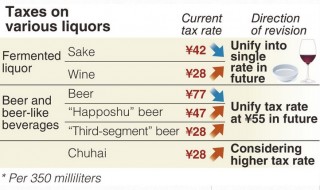Loading
Search
▼ Equal Tax Rates for Sake, Wine Considered
- Category:Other
The government and ruling parties are considering the unification of tax rates on sake and wine, aiming to simplify the nation’s complicated liquor tax system, according to sources.
They plan to gradually reduce the tax rate on sake while increasing the tax on wine. Such revisions are planned to be stipulated in the ruling bloc’s outline of tax system reform for fiscal 2017, which will be compiled in December.
The current tax rate for 350 milliliters of sake stands at ¥42, which is 50 percent higher than the ¥28 on wine. A plan being considered is to make both rates nearly the same in about 2020 and unify them at approximately ¥35 in about 2023.
There are also plans to raise the tax rates on chuhai spirits-and-soda drinks and highballs, a mix of whisky and soda. Both rates currently stand at ¥28 per 350 milliliters. The rates would increase to about ¥35, which is equivalent to what those for sake and wine would be by about 2026.
The sake industry and others have strengthened calls to revise the system, claiming that it is unfair to apply a lower rate to wine when both are fermented liquors. The plan to raise the rates on chuhai and highballs has been spurred by strong concern that if the conspicuously lower rates are maintained, they would put other liquor products at a disadvantage.
The government is also wary of worsening financial conditions. Even if chuhai and highballs become more popular, liquor tax revenue may decrease if sales of other alcoholic beverages plummet.
The ruling parties have started work on drastically revising the liquor tax system. They plan to present a road map to unify the tax rates on beer, “happoshu” low-malt quasi-beer and “third-segment” beer with little or no malt content in December. They hope to subsequently decide the rates on sake and wine after creating another road map to unify these rates.
The ruling parties may present the two road maps simultaneously by the end of the year if discussions progress smoothly.
However, an increase in the rates on chuhai and highballs, which are cheap and popular, might spark criticism. A wine tax hike is also expected to draw fire. Therefore, the government and ruling parties plan to proceed cautiously with revisions of the liquor tax.
They plan to gradually reduce the tax rate on sake while increasing the tax on wine. Such revisions are planned to be stipulated in the ruling bloc’s outline of tax system reform for fiscal 2017, which will be compiled in December.
The current tax rate for 350 milliliters of sake stands at ¥42, which is 50 percent higher than the ¥28 on wine. A plan being considered is to make both rates nearly the same in about 2020 and unify them at approximately ¥35 in about 2023.
There are also plans to raise the tax rates on chuhai spirits-and-soda drinks and highballs, a mix of whisky and soda. Both rates currently stand at ¥28 per 350 milliliters. The rates would increase to about ¥35, which is equivalent to what those for sake and wine would be by about 2026.
The sake industry and others have strengthened calls to revise the system, claiming that it is unfair to apply a lower rate to wine when both are fermented liquors. The plan to raise the rates on chuhai and highballs has been spurred by strong concern that if the conspicuously lower rates are maintained, they would put other liquor products at a disadvantage.
The government is also wary of worsening financial conditions. Even if chuhai and highballs become more popular, liquor tax revenue may decrease if sales of other alcoholic beverages plummet.
The ruling parties have started work on drastically revising the liquor tax system. They plan to present a road map to unify the tax rates on beer, “happoshu” low-malt quasi-beer and “third-segment” beer with little or no malt content in December. They hope to subsequently decide the rates on sake and wine after creating another road map to unify these rates.
The ruling parties may present the two road maps simultaneously by the end of the year if discussions progress smoothly.
However, an increase in the rates on chuhai and highballs, which are cheap and popular, might spark criticism. A wine tax hike is also expected to draw fire. Therefore, the government and ruling parties plan to proceed cautiously with revisions of the liquor tax.
- November 25, 2016
- Comment (0)
- Trackback(0)


